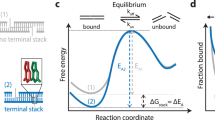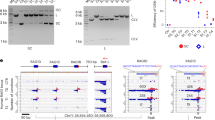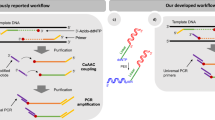Abstract
Two-dimensional strandness-dependent electrophoresis (2D-SDE) separates nucleic acids in complex samples according to strandness, conformation and length. Under the non-denaturing conditions of the first electrophoretic step, single-stranded DNA, double-stranded DNA and RNA·DNA hybrids of similar length migrate at different rates. The second electrophoretic step is performed under denaturing conditions (7 mol l−1 urea, 55 °C) so that all the molecules are single-stranded and separate according to length only. 2D-SDE is useful for revealing important characteristics of complex nucleic acid samples in manipulations such as amplification, renaturation, cDNA synthesis and microarray hybridization. It can also be used to identify mispaired, nicked or damaged fragments in double-stranded DNA. The protocol takes approximately 2 h and requires only basic skills, equipment and reagents.
This is a preview of subscription content, access via your institution
Access options
Subscribe to this journal
Receive 12 print issues and online access
$259.00 per year
only $21.58 per issue
Buy this article
- Purchase on Springer Link
- Instant access to full article PDF
Prices may be subject to local taxes which are calculated during checkout





Similar content being viewed by others
References
Nygaard, V. & Hovig, E. Options available for profiling small samples: a review of sample amplification technology when combined with microarray profiling. Nucleic Acids Res. 34, 996–1014 (2006).
Nagy, Z.B. et al. Real-time polymerase chain reaction-based exponential sample amplification for microarray gene expression profiling. Anal. Biochem. 337, 76–83 (2005).
Gunnarsson, G.H., Gudmundsson, B., Thormar, H.G., Alfredsson, A. & Jonsson, J.J. Two-dimensional strandness-dependent electrophoresis: a method to characterize single-stranded DNA, double-stranded DNA, and RNA–DNA hybrids in complex samples. Anal. Biochem. 350, 120–127 (2006).
Sambrook, J. & Russell, D.W. Molecular cloning: A Laboratory Manual (Cold Spring Harbor Laboratory Press, Cold Spring Harbor, NY, 2001).
Gunnarsson, G.H., Thormar, H.G., Gudmundsson, B., Akesson, L. & Jonsson, J.J. Two-dimensional conformation-dependent electrophoresis (2D-CDE) to separate DNA fragments containing unmatched bulge from complex DNA samples. Nucleic Acids Res. 32, e23 (2004).
Abels, J.A., Moreno-Herrero, F., van der Heijden, T., Dekker, C. & Dekker, N.H. Single-molecule measurements of the persistence length of double-stranded RNA. Biophys. J. 88, 2737–2744 (2005).
Lu, Y., Weers, B. & Stellwagen, N.C. DNA persistence length revisited. Biopolymers 61, 261–275 (2001).
Tinland, B., Pluen, A., Sturm, J. & Weill, G. Persistence length of single-stranded DNA. Macromolecules 30, 5763–5765 (1997).
Viovy, J.L. Electrophoresis of DNA and other polyelectrolytes: physical mechanisms. Rev. Mod. Phys. 72, 813–872 (2000).
Oleykowski, C.A., Bronson Mullins, C.R., Godwin, A.K. & Yeung, A.T. Mutation detection using a novel plant endonuclease. Nucleic Acids Res. 26, 4597–4602 (1998).
Henikoff, S., Till, B.J. & Comai, L. TILLING. Traditional mutagenesis meets functional genomics. Plant Physiol. 135, 630–636 (2004).
Lavrentieva, I. et al. High polymorphism level of genomic sequences flanking insertion sites of human endogenous retroviral long terminal repeats. FEBS Lett. 443, 341–347 (1999).
Ayliffe, M.A., Lawrence, G.J., Ellis, J.G. & Pryor, A.J. Heteroduplex molecules formed between allelic sequences cause nonparental RAPD bands. Nucleic Acids Res. 22, 1632–1636 (1994).
Vos, P. et al. AFLP: a new technique for DNA fingerprinting. Nucleic Acids Res. 23, 4407–4414 (1995).
Jensen, M.A. & Straus, N. Effect of PCR conditions on the formation of heteroduplex and single-stranded DNA products in the amplification of bacterial ribosomal DNA spacer regions. PCR Methods Applic. 3, 186–194 (1993).
Makrigiorgos, G.M., Chakrabarti, S., Zhang, Y., Kaur, M. & Price, B.D. A PCR-based amplification method retaining the quantitative difference between two complex genomes. Nat. Biotechnol. 20, 936–939 (2002).
Wang, G. et al. DNA amplification method tolerant to sample degradation. Genome Res. 14, 2357–2366 (2004).
Kittler, R., Stoneking, M. & Kayser, M. A whole genome amplification method to generate long fragments from low quantities of genomic DNA. Anal. Biochem. 300, 237–244 (2002).
Shagin, D.A., Lukyanov, K.A., Vagner, L.L. & Matz, M.V. Regulation of average length of complex PCR product. Nucleic Acids Res. 27, e23 (1999).
Dong, S. et al. Flexible use of high-density oligonucleotide arrays for single-nucleotide polymorphism discovery and validation. Genome Res. 11, 1418–1424 (2001).
Lucito, R. & Wigler, M. in DNA Microarrays (eds. Bowtell, D. & Sambrook, J.) 386–393 (Cold Spring Harbor Press, Cold Spring Harbor, NY, 2003).
Wellenreuther, R., Schupp, I., Poustka, A. & Wiemann, S. SMART amplification combined with cDNA size fractionation in order to obtain large full-length clones. BMC Genomics 5, 36 (2004).
Patel, O.V. et al. Validation and application of a high fidelity mRNA linear amplification procedure for profiling gene expression. Vet. Immunol. Immunopathol. 105, 331–342 (2005).
Lucito, R. & Wigler, M. in DNA Microarrays: A Molecular Cloning Manual (eds. Bowtell, D. & Sambrook, J.) 386–394 (Cold Spring Harbor Laboratory Press, Cold Spring Harbor, NY, 2003).
Acknowledgements
This work was supported by the Icelandic Research Council, the University of Iceland Research Fund, the Science Fund of Landspitali-University Hospital and BioCule Inc. BioCule Inc. has applied for a patent on the method. Authors G.H.G., B.G., H.G.T. and J.J.J. own stock and B.G. and H.G.T. are currently employed by BioCule. BioCule also funds research projects in J.J.J.'s research laboratory.
Author information
Authors and Affiliations
Corresponding author
Ethics declarations
Competing interests
BioCule Inc. has applied for a patent on the method. Authors GHG, BG, HGT and JJJ own stock and BG and HGT are currently employed by BioCule. BioCule also funds research projects in JJJ's research laboratory.
Rights and permissions
About this article
Cite this article
Gunnarsson, G., Gudmundsson, B., Thormar, H. et al. Two-dimensional strandness-dependent electrophoresis. Nat Protoc 1, 3011–3018 (2006). https://doi.org/10.1038/nprot.2006.477
Published:
Issue Date:
DOI: https://doi.org/10.1038/nprot.2006.477
Comments
By submitting a comment you agree to abide by our Terms and Community Guidelines. If you find something abusive or that does not comply with our terms or guidelines please flag it as inappropriate.



